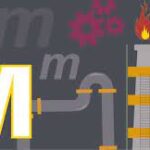NEUTRAL STEER – A vehicle that will maintain the selected turn with no driver input.
NON DIRECTIONAL SENSE – Steering does not lead in any direction.
NON LOAD CARRYING BODY – In this, the loads on the vehicle are transferred to the suspension system entirely by a separate chassis. The body is isolated from the chassis deflection by rubber mountings.
NOZZLE – The component containing the fuel valve and having one or more orifices through which fuel is injected.
NATURAL RUBBER – Natural rubber is obtained in the form of latex from the sap of Hevea brasiliensis and a few other plants. Crude rubber is coagulated by heat or by addition of electrolytes.
NAVAL BRASS – Alloy containing from 57.5-59.5% copper, 0.6-1.0% tin and not more than 0.75% of impurities, the balance being zinc (addition of tin improves the resistance of the alloy to corrosion by sea water). Used for under-water fittings of marine craft.
NEOPRENE – A synthetic rubber, highly resistant to oil, light, heat and oxidation.
NEUTRON – Elementary nuclear particle with a mass approximately the same as that of hydrogen atom and electrically neutral.
NICHROME – Alloy of nickel and chromium which is practically noncorrosive, can withstand high temperature without oxidation and is used for furnace components.
NICKEL – A strong, greyish, white, ductile metal, which has high resistance to oxidation and corrosion. Therefore, used in pure form for some applications, such as plating. It is more usually alloyed with other metals.
NICKEL BRONZE – Bronze alloy of which there are two main series (1) low nickel bronze (nickel below 5%) used, for bronze castings, and (2) high nickel bronze (nickel over 10%) resistant to heat, and to corrosive attack from chemical liquors.
NICKEL SILVER – Also called GERMAN SILVER. Alloy with composition copper 60%, zinc 20%, and nickel 20%. Class of alloys used in the manufacture of electrical resistance coils and elements, decorative articles for which its lustrous colour (which increases in whiteness with nickel content) make it very suitable, or for heavy duty works such as high pressure steam fittings.
NICROSILAL – A nickel-chromium alloy cast iron having a composition 1.7% carbon, 4.5% silicon, 0.8% manganese, 18.0% nickel, and 2% chromium, the balance is iron.
NIMONIC ALLOY – Nickel base alloy possessing high resistance to heat and corrosion, used for components in gas turbines and jet propulsion engines.
NIRESIST IRON – Alloy cast iron (typical composition 14% nickel, 1.5% silicon, 1 % manganese, and 3% carbon and remainder iron) which possesses exceptional resistance to heat and corrosion.
NISPAN ALLOY – Range of alloys having controlled expansion and elastic properties.
NITENSYL – Group of cast iron which have a tensile strength of 23-25 tons./sq. inch by suitable heat treatment. A typical composition is 1.5% nickel, 1.5% silicon, 2.9% carbon and 0.8% manganese, the balance being iron.
NITRALLOYS – Nitralloys are the steels developed for nitriding process. The commonly used grades contain 0.20 to 0.40 per cent carbon, 0.9 to 1.5 percent Cr, 0.80 to 1.20 per cent Al, and small additions of Mo, Si, and Mn.
NODULAR CAST IRON – A cast iron that has been treated while molten with a master alloy containing an element such as magnesium or cerium to give primary graphite in the spherulitic form.
NODULAR GRAPHITE – Graphite or carbon in the form of spheroids.
NOMAG – Non-magnetic cast iron, used for castings in electric motors and alternators and similar applications. A typical composition is 11% nickel, 1.5% silicon, 3% total carbon, up to 7% manganese, the balance being iron.
NON-FERROUS – Metals and alloys which do not contain any large proportion of iron, examples being brass, copper, aluminium and lead.
NUCLEUS – (1) The first structurally stable particle capable of initiating recrystallisation of a phase or the growth of a new phase and possessing an interface with the parent matrix. (2) The heavy central core of an atom in which most of the mass and the total positive electric charge are concentrated.
NYLON – A group of plastics of nitrogenous structure known as polyamides which are crystalline in nature and can be so processed as to orient the crystals axially thus making the tensile strength of fibres extremely high.
NEEDLE BEARING – Antifriction bearing of the roller type, the rollers are very small in diameter (needle sized). Rollers have a length over four times greater than their diameter.
NEEDLE LUBRICATOR – A needle which rests on a journal and exposed at top to the oil in an inverted glass bottle or reservoir, causes oil to flow slowly onto the journal, due to the vibration set up during shaft rotation.
NATURAL DRAFT – Draft produced by a chimney, by a column of hot gases existing inside the chimney.
NATURAL GAS – Gas obtained from petroleum mines.
NOx – Oxides of nitrogen, a by-product of combustion within the combustion chamber at high temperature and under heavy load. A basic air pollutant.
NOx CONTROL – Any type of device, or system, used to reduce the amount of NOx produced by an engine.
NO LEAD FUEL – Gasoline to which there has been no intentional addition of lead compounds.
NET JET THRUST – That part of the thrust of a turbojet engine which is available for climb and acceleration.
NOZZLE – A flow passage specially shaped to produce kinetic energy at the expense of other forms of energy (available thermal energy).
NOZZLE EFFICIENCY – The ratio of the actual kinetic energy produced on discharge (or between any two points in a nozzle) to that obtainable by assuming an isentropic expansion in the nozzle.
NEGRADIZING – Rust proofing process in which a ferrosoferric oxide surface is produced on steel or iron.
NICKEL PLATING – Deposition of nickel on a metal by electrolytic action to provide a protective surface or to build up the surface of a worn or undersize part.
NITRIDING – A process of case hardening in which a special ferrous alloy is heated in an atmosphere of ammonia or is in contact with any other nitrogenous material. By this, surface hardening is achieved by the absorption of nitrogen without quenching.
NORMALIZING – Process applied to iron base alloys, such as steel, to refine the grain structure and remove the effects of previous processing for example hot rolling.
NO LOAD TEST – A cranking motor test in which the cranking motor is operated without load, the current drawn and the armature speed at the specified voltage are noted.
NUT – A metal fastener of square, hexagon or other shape having an internal thread which screws onto a bolt, stud, or arbor.
NUT BOX MECHANISM – In a lathe it is used to engage and disengage the lead screw for thread cutting. This comprises a pair of half-nuts capable of sliding in vertical slides in or out of mesh with the lead screw.
NUT – A metal fastener of square, hexagon or other shape, having an internal
thread which screws onto a bolt, stud or arbor.
NIBBLER – Machine designed to cut metals in sheet form to any required shape. The machine comprises a small punch moving up and down at high speed, and so taking a considerable number of small nibbles or cuts.
NUT TAPPING MACHINE – Device for tapping, that is providing the screw threads on nuts.
NON-SPINNING ROPES – Multilayer constructions having alternately opposite lays of individual layers.
NOTCH BRITTLENESS – Susceptibility of a material to brittle fracture at points of stress concentration.
NOTCH DUCTILITY – The percentage reduction in area after complete separation of the metal in a notch tensile test.
NOTCH RUPTURE STRENGTH – The ratio of applied load to original area of the minimum cross-section in a stress rupture test of a notched specimen.
NOTCH SENSITIVITY – A measure of the reduction in strength of a metal caused by the presence of stress concentration.
NOTCH TOUGHNESS – The resistance to fracture of a metal specimen having a notch or groove when subjected to a sudden load, usually tested on an Izod-Charpy testing machine.
NOTCHING – Operation of cutting gaps on the edge of an article.
NORMAL ACCELERATION – The time rate of change of velocity of a point in a direction normal to its path. This results from a change in the direction of its linear velocity.
NONFLEXING RING PLATE TYPE VALVE – One type of valve commonly used in compressors.
NONFROSTING EVAPORATORS – Use only the thermostatic expansion valve type of refrigerant control, operate at a temperature close to freezing.
NONMECHANICAL REFRIGERATION SYSTEMS – Those that obtain the required high and low pressures by some method other than a mechanical compressor.
NORMAL COMBUSTION – refers to the combustion of the entire air fuel mixture in the SI engine combustion chamber, layer by layer by the moving flame.
NATURAL DRAFT – The draft caused by the difference in weight between the column of hot gas inside the chimney and a column of cool outside air of the same height and cross-section.
NET FEED WATER – The quantity of water necessary to supply a stated evaporation in a given interval of time.
NON-SECTIONAL BOILER – A boiler in which the tubes are divided into groups, each group communicating with a header at each end, making independent units.
NATURAL POND – A natural flow pond having no baffle walls or spray nozzle.
NET EFFICIENCY – Ratio of network delivered at shaft to the total energy supplied to the steam turbine/steam engine. In the case of steam turbine it is the product of nozzle efficiency, diagram efficiency and mechanical efficiency.
NOZZLE – A duct of smoothly varying cross-sectional area in which a steadily flowing fluid can be made to accelerate by a pressure drop along the duct.
NOZZLE CONTROL GOVERNING – Governing arrangement in which nozzles are grouped together in three or five or more groups and each group of nozzles is supplied with steam which is controlled by valves.
NOZZLE EFFICIENCY – Ratio of the actual enthalpy drop to the isentropic enthalpy drop between the same pressures.
NOZZLE THROAT – The section of the nozzle where the area is minimum.
NATURAL CONVECTION – Circulation or the transfer of fluid due to a difference in density resulting from temperature changes.
NATURAL DRAFT COOLING TOWER – Cooling tower which cools water by moving air at low velocities through the tower, without the aid of any mechanical means.
NON FLOW PROCESS – It is the one in which there is no mass interaction across the system boundaries during the process. This occurs in a closed system.
NTP – The normal temperature and pressure refer to the conditions of temperature 0°C (273 K) and pressure of 760 mm of mercury.
NON-PRIMARY KICKSTART – A kick-start system which uses gearbox input shaft and clutch hub to connect kick-start lever to crank shaft. For starting, gearbox must be in neutral and clutch engaged.
NON-UNIT CONSTRUCTION – Engine design with separate engine crankcase and gearbox case.
NEUTRAL FLAME – An oxyfuel gas flame in which the proportion used is neither oxidizing nor reducing.
NON-DESTRUCTIVE TESTING – Testing of welds or metal without causing any damage to the item being tested.


